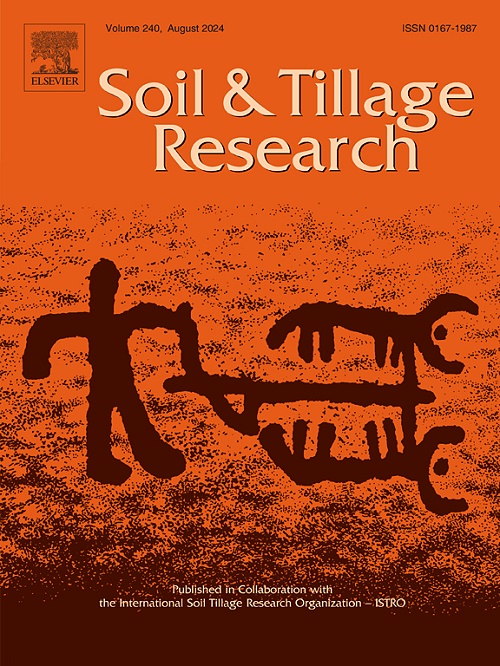Measuring and mapping moisture content in agricultural fields by neutron-gamma analysis
IF 6.1
1区 农林科学
Q1 SOIL SCIENCE
引用次数: 0
Abstract
All currently applied methods for soil moisture measurement and mapping in agricultural fields are labor-intensive and time-consuming. The Pulsed Fast Thermal Neutron Analysis (PFTNA) method, described in this article, can provide in situ soil moisture distribution data across agricultural fields by field scanning with a mobile PFTNA system in a reasonably short time. This method is based on acquiring soil gamma ray responses when irradiated by fast neutrons. The response gamma spectra [thermal neutron capture (TNC) gamma spectra] contain the gamma ray peak related to hydrogen present in soil. Since the majority of hydrogen is contained in soil water, soil moisture can be determined from the value of the hydrogen peak area in TNC spectra. A power dependency with a non-zero constant term was used to convert the hydrogen peak area to soil moisture content. To create this dependency, the hydrogen peak area in the TNC spectra was plotted against moisture data obtained using other methods (gravimetric, time domain reflectometry, nuclear radiation transmission) in the same agricultural fields. Developed methods for PFTNA field scanning and data processing provided data for moisture mapping; this scanning method involved moving at 5 km h−1, simultaneously recording GPS coordinates and TNC gamma spectra every 30 s, and scanning paths that uniformly covered surveyed fields. Comparison of these maps with those created using data from traditional soil moisture measurement methods (gravimetric, time domain reflectometry, nuclear radiation transmission) demonstrated good agreement. Note that PFTNA scanning of a 20-hectare field can acquire the data needed for mapping in approximately one hour. Thus, PFTNA scanning can be recommended as a more efficient method for measuring and mapping soil moisture in agricultural fields.
用中子-伽马分析测定和测绘农田水分含量
目前在农业领域应用的土壤水分测量和制图方法都是劳动密集型和耗时的。本文介绍的脉冲快热中子分析(PFTNA)方法可以在相当短的时间内通过移动PFTNA系统进行现场扫描,提供农田土壤水分分布数据。该方法的基础是获取快中子照射土壤时的伽马射线响应。响应伽马谱[热中子捕获(TNC)伽马谱]包含与土壤中存在的氢有关的伽马射线峰。由于土壤水分中含有大部分氢,因此可以通过TNC光谱中氢峰面积的大小来确定土壤水分。利用非零常数项的功率依赖关系将氢峰面积转换为土壤含水量。为了建立这种依赖关系,将TNC光谱中的氢峰面积与使用其他方法(重力法、时域反射法、核辐射透射法)在同一农田中获得的水分数据进行了对比。开发了PFTNA现场扫描和数据处理方法,为水分制图提供了数据;该扫描方法以5 km h−1的速度移动,每30 s同时记录GPS坐标和TNC伽马谱,扫描路径均匀覆盖被测场。将这些地图与使用传统土壤湿度测量方法(重力测量、时域反射法、核辐射透射法)的数据绘制的地图进行比较,结果显示出良好的一致性。请注意,PFTNA扫描20公顷的田地可以在大约一个小时内获得测绘所需的数据。因此,可以推荐PFTNA扫描作为一种更有效的测量和绘制农田土壤湿度的方法。
本文章由计算机程序翻译,如有差异,请以英文原文为准。
求助全文
约1分钟内获得全文
求助全文
来源期刊

Soil & Tillage Research
农林科学-土壤科学
CiteScore
13.00
自引率
6.20%
发文量
266
审稿时长
5 months
期刊介绍:
Soil & Tillage Research examines the physical, chemical and biological changes in the soil caused by tillage and field traffic. Manuscripts will be considered on aspects of soil science, physics, technology, mechanization and applied engineering for a sustainable balance among productivity, environmental quality and profitability. The following are examples of suitable topics within the scope of the journal of Soil and Tillage Research:
The agricultural and biosystems engineering associated with tillage (including no-tillage, reduced-tillage and direct drilling), irrigation and drainage, crops and crop rotations, fertilization, rehabilitation of mine spoils and processes used to modify soils. Soil change effects on establishment and yield of crops, growth of plants and roots, structure and erosion of soil, cycling of carbon and nutrients, greenhouse gas emissions, leaching, runoff and other processes that affect environmental quality. Characterization or modeling of tillage and field traffic responses, soil, climate, or topographic effects, soil deformation processes, tillage tools, traction devices, energy requirements, economics, surface and subsurface water quality effects, tillage effects on weed, pest and disease control, and their interactions.
 求助内容:
求助内容: 应助结果提醒方式:
应助结果提醒方式:


